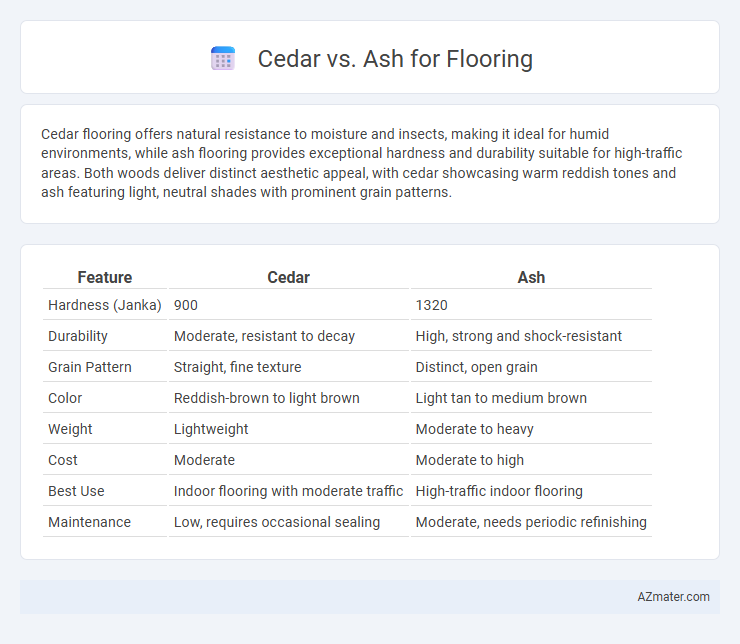Cedar flooring offers natural resistance to moisture and insects, making it ideal for humid environments, while ash flooring provides exceptional hardness and durability suitable for high-traffic areas. Both woods deliver distinct aesthetic appeal, with cedar showcasing warm reddish tones and ash featuring light, neutral shades with prominent grain patterns.
Table of Comparison
| Feature | Cedar | Ash |
|---|---|---|
| Hardness (Janka) | 900 | 1320 |
| Durability | Moderate, resistant to decay | High, strong and shock-resistant |
| Grain Pattern | Straight, fine texture | Distinct, open grain |
| Color | Reddish-brown to light brown | Light tan to medium brown |
| Weight | Lightweight | Moderate to heavy |
| Cost | Moderate | Moderate to high |
| Best Use | Indoor flooring with moderate traffic | High-traffic indoor flooring |
| Maintenance | Low, requires occasional sealing | Moderate, needs periodic refinishing |
Overview: Cedar vs Ash Flooring
Cedar flooring offers natural resistance to moisture, insects, and decay, making it ideal for areas prone to humidity. Ash flooring is prized for its hardness and durability, featuring a light color with distinctive grain patterns that blend well in modern or rustic interiors. Both woods provide unique aesthetics and performance traits, with ash being harder and more resilient under heavy foot traffic, while cedar delivers warmth and aromatic benefits.
Wood Characteristics and Appearance
Cedar flooring is prized for its rich reddish-brown hues and natural resistance to decay, featuring a fine, straight grain that offers a smooth, warm appearance ideal for rustic and cozy interiors. Ash flooring stands out with its light beige to pale brown color, showcasing a pronounced, straight grain pattern that adds a contemporary, bright aesthetic to modern spaces. Both woods provide durability, but ash is harder and more resistant to dents, making it suitable for high-traffic areas, while cedar offers enhanced natural oils that improve its longevity and insect resistance.
Durability and Hardness Comparison
Cedar flooring is prized for its natural resistance to moisture and decay, offering moderate hardness with a Janka rating around 900, which makes it softer but more prone to dents and scratches compared to ash. Ash flooring provides superior durability and hardness, with a Janka rating near 1320, making it more resistant to wear and ideal for high-traffic areas. The higher density of ash wood contributes to its long-lasting performance and better ability to withstand impacts, whereas cedar offers a softer, warmer aesthetic with slightly lower durability.
Color and Grain Differences
Cedar flooring features warm reddish tones and a fine, straight grain that creates a smooth, uniform appearance ideal for rustic or traditional interiors. Ash wood flooring showcases a lighter, creamy color with pronounced, bold grain patterns, offering a more modern and dynamic aesthetic. The color contrast between cedar's rich hue and ash's pale shade allows homeowners to select flooring that complements varying design preferences and lighting conditions.
Cost Considerations
Cedar flooring generally costs between $5 and $10 per square foot, making it a moderately priced option compared to other hardwoods, while ash flooring ranges from $6 to $12 per square foot due to its durability and hardness. Installation costs for both woods can vary, but ash often requires more intensive finishing techniques that may increase labor expenses. Cedar's cost-effectiveness is enhanced by its natural resistance to decay, lowering long-term maintenance costs compared to ash, which may require additional sealing or treatments to maintain appearance.
Maintenance and Longevity
Cedar flooring offers natural resistance to moisture and decay, requiring minimal maintenance such as periodic sealing and cleaning to preserve its appearance and durability. Ash flooring is known for its hardness and wear resistance, demanding occasional refinishing to maintain its surface integrity over decades. Both woods provide long-lasting performance, but ash generally outperforms cedar in longevity due to its superior strength and abrasion resistance.
Resistance to Moisture and Decay
Cedar flooring offers superior resistance to moisture and decay due to its natural oils and tight grain structure, making it ideal for humid environments and areas prone to dampness. Ash, while strong and hard, is less resistant to moisture and requires proper sealing to prevent warping and rot over time. Choosing cedar over ash for flooring ensures enhanced durability and longer lifespan in moisture-prone conditions.
Suitability for High-Traffic Areas
Ash flooring is highly suitable for high-traffic areas due to its superior hardness and durability, rating around 1320 on the Janka hardness scale, which makes it resistant to dents and wear. Cedar, with a softer rating of approximately 900 on the Janka scale, tends to scratch and dent more easily under heavy use, making it less ideal for areas with frequent foot traffic. For commercial spaces or busy households, ash provides a long-lasting, resilient flooring option that maintains its appearance over time.
Environmental Impact and Sustainability
Cedar flooring offers a lower environmental impact due to its faster growth rate and higher carbon sequestration compared to ash, which requires longer growth periods and more extensive harvesting. Ash flooring involves more intensive processing and transportation emissions, whereas cedar's natural resistance to decay reduces the need for chemical treatments, enhancing its sustainability profile. Choosing cedar supports sustainable forestry practices by enabling quicker replenishment cycles and minimizing habitat disruption.
Best Use Cases: Cedar vs Ash in Flooring
Cedar flooring excels in moisture-prone environments like bathrooms and basements due to its natural resistance to decay and insect damage. Ash flooring is ideal for high-traffic areas such as living rooms and hallways because of its exceptional hardness and durability. Both woods offer distinct aesthetic appeal, with cedar providing warm reddish tones and ash presenting a light, creamy finish suitable for modern interiors.

Infographic: Cedar vs Ash for Flooring
 azmater.com
azmater.com